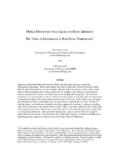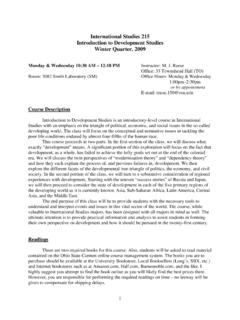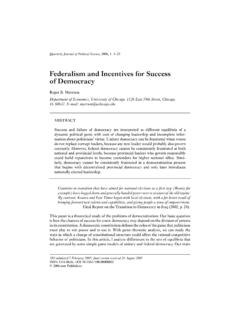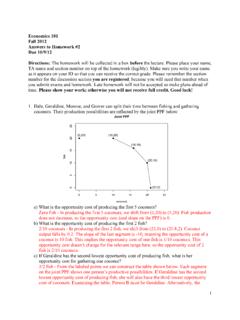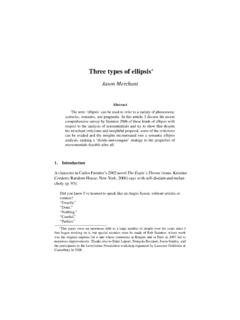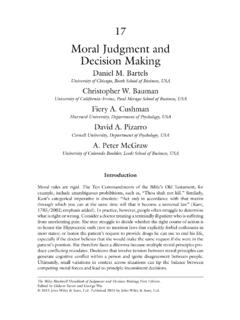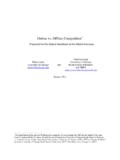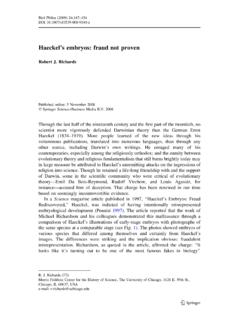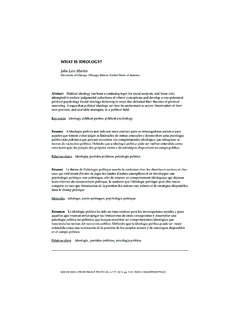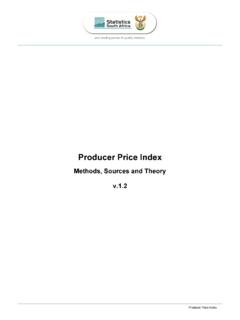Transcription of What Determines Productivity?
1 Journal of Economic Literature 2011, 49:2, 326 365. What Determines productivity ? Chad Syverson*. Economists have shown that large and persistent differences in productivity levels across businesses are ubiquitous. This finding has shaped research agendas in a num- ber of fields, including (but not limited to) macroeconomics, industrial organization, labor, and trade. This paper surveys and evaluates recent empirical work address- ing the question of why businesses differ in their measured productivity levels. The causes are manifold, and differ depending on the particular setting. They include ele- ments sourced in production practices and therefore over which producers have some direct control, at least in theory as well as from producers ' external operat- ing environments.
2 After evaluating the current state of knowledge, I lay out what I. see are the major questions that research in the area should address going forward. ( JEL D24, G31, L11, M10, O30, O47). 1. Introduction persistent measured productivity differences across producers , even within narrowly T hanks to the massive infusion of detailed production activity data into economic study over the past couple of decades, defined industries. The magnitudes involved are striking. Chad Syverson (2004b) finds that within four- researchers in many fields have learned a digit SIC industries in the manufactur- great deal about how firms turn inputs into ing sector, the average difference in logged outputs.
3 productivity , the efficiency with total factor productivity (TFP) between an which this conversion occurs, has been a industry's 90th and 10th percentile plants topic of particular interest. The particulars is This corresponds to a TFP ratio of of these studies have varied depending on = To emphasize just what this the researchers' specific interests, but there number implies, it says that the plant at the is a common thread. They have documented, 90th percentile of the productivity distribu- virtually without exception, enormous and tion makes almost twice as much output with the same measured inputs as the 10th per- * University of Chicago and National Bureau of Eco- centile plant.
4 Note that this is the average nomic Research. I thank Eric Bartelsman, Nick Bloom, 90 10 range. The range's standard deviation Roger Gordon, John Haltiwanger, Chang-Tai Hsieh, Ariel Pakes, Amil Petrin, John Van Reenen, and anonymous across four-digit industries is , so sev- referees for helpful comments. This work is supported by eral industries see much larger productiv- the NSF (SES-0519062 and SES-0820307), and both the ity differences among their producers . Stigler Center and the Centel Foundation/Robert P. Reuss Faculty Research Fund at the University of Chicago Booth manufacturing is not exceptional in terms of School of Business.
5 productivity dispersion. Indeed, if anything, 326. Syverson: What Determines productivity ? 327. it is small relative to the productivity varia- by no means is it meant to be a comprehen- tion observed elsewhere. Chang-Tai Hsieh sive accounting. They speak to the breadth and Peter J. Klenow (2009), for example, of the impact that answers to this paper's title find even larger productivity differences in question would have. China and India, with average 90 10 TFP Macroeconomists are dissecting aggregate ratios over 5 productivity growth the source of almost all These productivity differences across pro- per capita income differences across coun- ducers are not fleeting, either.
6 Regressing tries into various micro-components, with a producer's current TFP on its one-year- the intent of better understanding the sources lagged TFP yields autoregressive coefficients of such growth. Foster, Haltiwanger, and C. on the order of to (see, , rp d J. Krizan (2001), for example, overview the brah m and Kirk White 2006 and Foster, substantial role of reallocations of economic Haltiwanger, and Syverson 2008). Put sim- activity toward higher productivity produc- ply, some producers seem to have figured out ers (both among existing plants and through their business (or at least are on their way), entry and exit) in explaining aggregate pro- while others are woefully lacking.
7 Far more ductivity growth. Hsieh and Klenow (2009). than bragging rights are at stake here: another ask how much larger the Chinese and Indian robust finding in the literature virtually economies would be if they achieved the invariant to country, time period, or indus- same efficiency in allocating inputs across try is that higher productivity producers are production units as does the United States. more likely to survive than their less efficient Models of economic fluctuations driven by industry competitors. productivity is quite lit- productivity shocks are increasingly being erally a matter of survival for businesses. enriched to account for micro-level patterns, and are estimated and tested using plant- How Micro-Level productivity or firm-level productivity data rather than Variation and Persistence Has aggregates ( , Jeffrey R.)
8 Campbell and Influenced Research Jonas D. M. Fisher 2004, Eric J. Bartelsman, The discovery of ubiquitous, large, and per- Haltiwanger, and Stefano Scarpetta 2009, sistent productivity differences has shaped and Marcelo Veracierto 2008). Micro pro- research agendas in a number of fields. Here ductivity data have also been brought to bear are some examples of this influence, though on issues of long-run growth, income conver- gence, and technology spillovers. They offer 1 These figures are for revenue-based productivity mea- a level of resolution unattainable with aggre- sures; , where output is measured using plant revenues gated data.
9 (deflated across years using industry-specific price indexes). In industrial organization, research has TFP measures that use physical quantities as output mea- sures rather than revenues actually exhibit even more linked productivity levels to a number of variation than do revenue-based measures as documented features of technology, demand, and market in Lucia Foster, John Haltiwanger, and Syverson (2008). structure. Examples include the effect of Hsieh and Klenow (2009) also find greater productivity dispersion in their TFP measures that use quantity proxies competition (Syverson 2004a and James A. to measure output (actual physical quantities are not avail- Schmitz 2005), the size of sunk costs (Allan able for most producers in their data).)
10 Even though it is Collard-Wexler 2010), and the interaction of only a component of revenue-based TFP (the other being the producer's average price), quantity-based TFP can be product market rivalry and technology spill- more dispersed because it tends to be negatively corre- overs (Nicholas Bloom, Mark Schankerman, lated with prices, as more efficient producers sell at lower and John Van Reenen 2007). Another line of prices. Thus revenue-based productivity measures, which combine quantity-based productivity and prices, tend to study has looked at the interaction of firms'. understate the variation in producers ' physical efficiencies.
